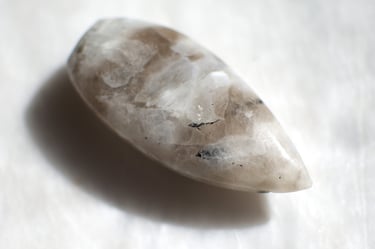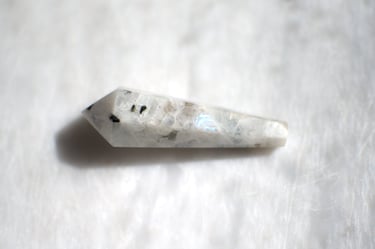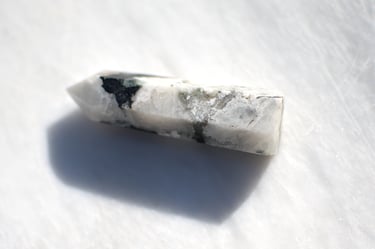Rainbow Moonstone
Spiritual awakening, protection, emotional healing, intuition, balance
Metaphysical Properties:
Rainbow Moonstone is a stone of intuition and spiritual awakening. It enhances psychic abilities, promotes emotional healing, and strengthens one’s connection to the Divine Feminine. Known for its calming energy, it brings balance and protection, helping to transmute negative energy.
Symbolism & Associations:
Rainbow Moonstone embodies the cycles of the moon, making it an excellent stone for manifesting intentions and aligning with natural rhythms. It is also linked to the Divine Feminine, intuition, and emotional healing.
Chakra Alignment:
Primarily associated with the Crown and Third Eye chakras, it enhances inner vision and promotes spiritual growth.
Planets:
Moon, Venus
Zodiacs:
Cancer, Libra, Scorpio
Elements:
Water, Earth
Similar Stones:
Labradorite, Silver Flash Larvikite, Sunstone, Opal
Correspondences:
Colours: White, silver, blue, opalescent rainbow
Crystals: Selenite, Labradorite, Amethyst
Flowers: Jasmine, Moonflower, White Rose
Herbs: Mugwort, Chamomile, White Sage
Essential Oils: Jasmine, Lavender, Clary Sage
Incense: Jasmine, Myrrh, Sandalwood, Ylang Ylang
Metals: Silver
Months, Days, & Seasons: June, Monday (moon day), Spring, Autumn
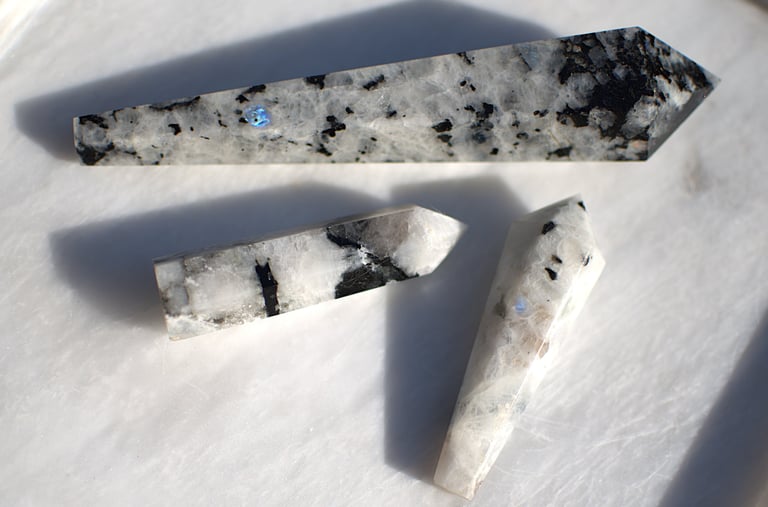

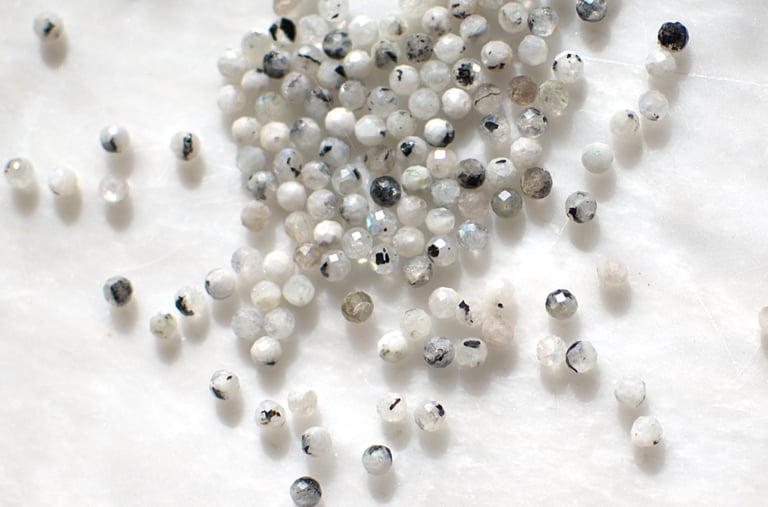

Facts
Stone Type:
Feldspar — a stone family which includes Labradorite, Moonstone, Spectrolite, and Larvikite.
Hardness Rating:
6-6.5 on the Mohs scale, so soft and easily scratchable.
Chemical Formula:
KAlSi3O8 (Potassium Aluminium Silicate)
Care Guide
Avoid placing it in direct contact with hard surfaces or sharp objects. To clean the stone, use a soft cloth and avoid abrasive cleaners. Always store it separately from other stones that may cause scratches. Avoid exposing it to excessive heat, as it may damage the stone’s surface.
Spiritual
Rainbow Moonstone is often used to promote spiritual awakening, enhance intuition, and connect with the Divine Feminine energy. It is ideal for rituals focused on personal growth, manifestation, and emotional healing.
Healing
Rainbow Moonstone supports the reproductive system, regulates hormones, and balances fluid levels in the body. It is also believed to strengthen the immune system.
Cleansing
To cleanse Rainbow Moonstone, place it in moonlight overnight or use sound vibrations such as a tuning fork or singing bowl. You can also smudge the stone with sage or palo santo to reset its energy. Avoid using saltwater or harsh chemicals, as it can affect the stone’s surface.
Affirmations
“I am open to receiving spiritual guidance and intuition.”
“I trust in the divine cycles of nature.”
“I embrace emotional healing and balance in my life.”
“I am connected to the nurturing energies of the moon.”
Meditation
Hold the stone or place it on your Third Eye or Crown Chakra. Visualise a calming, iridescent light surrounding you. Excellent for intuitive clarity and emotional renewal.
Astrology
Aligned with the Moon, beneficial to Cancer, Libra, and Scorpio. Its watery energy encourages emotional depth, reflection, and calm.
Vibration
Rainbow Moonstone carries a high, luminous vibration aligned with lunar and divine energy. It’s ideal for those raising their frequency for intuitive work and spiritual expansion.
Did You Know:
Rainbow Moonstone isn’t actually a moonstone at all! It’s a variety of Labradorite that displays a beautiful rainbow flash, often mistaken for true moonstone. The name was popularised by gem cutters and collectors due to its resemblance to Orthoclase Moonstone — but mineralogically, they’re cousins in the Feldspar family, not twins!
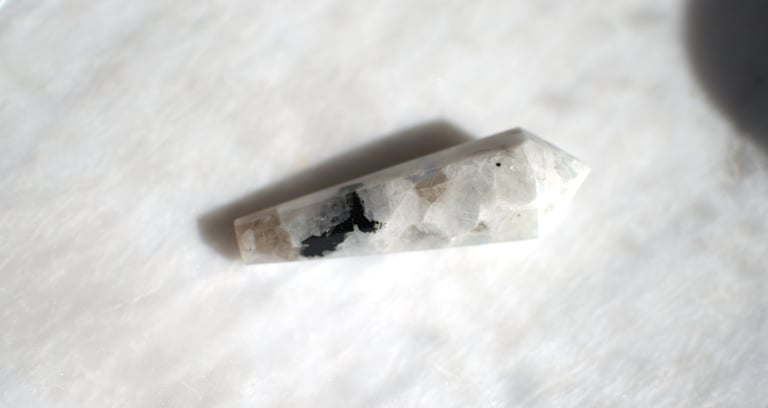

Mythology & Folklore
Rainbow Moonstone has been revered across cultures for centuries, often linked to the moon and feminine deities. In Hindu mythology, it is considered a sacred and magical stone believed to be composed of solidified moonbeams. According to legend, placing a Rainbow Moonstone in the mouth during a full moon could allow one to see their future. It is also closely associated with the god Chandra, the Moon God, and was used in ceremonial offerings and worn for blessings.
In Roman mythology, Moonstone was believed to be formed from drops of moonlight and closely connected to Diana, the goddess of the moon, intuition, and protection. It was used as a talisman for love, fertility, and to ensure safe travel, especially at night.
In Eastern European and Slavic folklore, Moonstone was often associated with goddess worship and believed to bring harmony and fertility to marriages. It was thought to help lovers see each other clearly and resolve misunderstandings by revealing emotional truths. Many cultures believed that the stone could be influenced by the phases of the moon and might even appear to grow or glow stronger under its light.
In medieval lore, Rainbow Moonstone was worn as a protective charm for travellers—especially at sea—as the moon governs tides and water. Some believed it held a living spirit inside, awakened by moonlight. It was also thought to bring prophetic dreams and connect the wearer to hidden realms.
Historical Significance
Historically, Rainbow Moonstone (and related moonstones) has been used in jewellery and ceremonial tools since ancient times, particularly in India, Greece, and Rome. In India, it has long been part of traditional Ayurvedic practices, used for calming the mind, balancing emotions, and enhancing meditation. Indian artisans frequently used it in spiritual jewellery, believing it brought blessings and divine feminine energy.
In ancient Rome, moonstone was prized for its mystical appearance and was believed to bring harmony, reconciliation, and clairvoyance. Roman naturalist Pliny the Elder even described its shifting light as being tied to the phases of the moon, and it was highly sought after in carved intaglios and amulets.
During the Art Nouveau period (late 19th – early 20th century), moonstone—especially rainbow varieties—gained a resurgence in popularity. Renowned jewellers like René Lalique and Georges Fouquet incorporated it into ethereal, nature-inspired pieces, celebrating its connection to fantasy, femininity, and emotional depth.
In Victorian England, Moonstone was also a popular “lover’s stone,” often set into brooches and rings gifted between sweethearts. It was said to help couples attune to each other’s emotions and promote fidelity.
Across all eras, it’s been consistently used as a stone of magic, protection, and feminine insight, often found in the sacred tools of priestesses, seers, and healers.
Origin & Formation
Rainbow Moonstone is technically a form of Labradorite within the Feldspar family, rather than a true Moonstone (which is Orthoclase). This confusion arises because both stones exhibit similar light phenomena — but in Rainbow Moonstone, the shimmer is due to labradorescence, while true Moonstone shows adularescence. Both occur because of the way light scatters between microscopic layers of the crystal structure.
The term “Rainbow Moonstone” was popularised by lapidaries and traders to describe this gem’s characteristic multi-coloured flashes, often in blue, violet, gold, or even pink, depending on the angle of light. It is valued for its ethereal appearance and spiritual associations, especially with intuition, emotional healing, and the divine feminine.
Geologically, Rainbow Moonstone forms in plutonic igneous rocks, where slow cooling allows the development of layered feldspar structures that give the stone its optical qualities. It's commonly found as massive or tumbled stones, though high-grade specimens with strong colour play are faceted for jewellery use.
Main sources:
India (primary commercial source)
Sri Lanka (noted for clarity and strong blue flash)
Madagascar
Mexico
Australia
Poland
Variation & Quality
Rainbow Moonstone is a captivating member of the feldspar family, prized for its adularescence—the phenomenon where light plays across the surface of the stone, creating a shimmering, iridescent glow. This shimmering effect, often appearing as flashes of blue, white, or multicolour, is what gives Rainbow Moonstone its name. The variations in appearance are a result of differences in the stone’s formation, the quality of the adularescence, and the mineral composition of the specific deposits.
High-Quality Translucent Rainbow Moonstone is known for its intense, consistent flash of colour, especially blue or multicoloured hues. The more vivid and vibrant the adularescence, the higher the stone’s value. This high-quality material is often used in fine jewellery, where the effect is displayed to its fullest potential. The most sought-after stones have a transparent or semi-transparent body, with a smooth, polished surface that showcases the light play. These stones are usually cut into cabochons or domed shapes to highlight the unique optical phenomenon. Translucent Rainbow Moonstone has been completely mined out from the existing known sources, so the only source for jewellery is recycling old jewellery with translucent stones. This makes high grade Rainbow Moonstone extremely expensive to purchase, and rare to find.
Medium To Low Quality Rainbow Moonstone tends to have a more subdued adularescence. These stones typically have a milky or cloudy body colour, and the light play may appear more diffused or subtle. While these stones are still extremely beautiful and still carry strong metaphysical qualities, they are less prized in the jewellery market and are often used for beads, pendants, or decorative pieces.
Black Rainbow Moonstone, sometimes called Black Moonstone, is a rarer variety that features the signature play of light but against a dark, almost black background. This variety tends to be highly protective and grounding, with a more pronounced, deep energy. It can offer additional qualities of protection, grounding, and stability, making it particularly valued for those seeking to block out negative energy and establish a firm spiritual foundation.
Rainbow Moonstone with inclusions can be quite striking, especially when the inclusions catch the light and create unique patterns within the stone. These inclusions can sometimes be viewed as imperfections, but in the case of Rainbow Moonstone, they often enhance its mystical beauty. Some inclusions may appear as specks or veins, while others might manifest as cloudy or milky swirls within the translucent stone. These stones are considered especially powerful in terms of emotional healing, as the inclusions are seen as symbols of the complexities of human experience.
Rainbow Moonstone is typically cut into cabochons to show off its adularescence to the best effect. However, it can also be found in faceted forms, though this is less common because faceting can diminish the play of light. Stones that are cut improperly or too thinly may not showcase the characteristic glow, leading to a less effective display of its magical qualities. Some Rainbow Moonstone is treated or stabilised to enhance its durability or to bring out its colour. However, these treated stones are less valuable than natural, untreated stones.
Notes
Rainbow Moonstone is highly regarded in spiritual and metaphysical circles for its deep connection to the moon and feminine energy. As a stone of intuition and spiritual awakening, it is often used to enhance intuition, psychic abilities, and inner vision. Many people are drawn to Rainbow Moonstone for its ability to balance and harmonize the emotional body, as well as for its connection to the divine feminine.
This gemstone is popularly used in bohemian-style jewellery, often paired with other natural gemstones or metalwork that complement its mystical and ethereal energy. The stone's shimmering colours and ability to reflect different shades of light make it a striking choice in pendants, earrings, and rings. Rainbow Moonstone is often seen in goddess jewellery, as it is associated with lunar deities and is thought to aid in spiritual journeys and self-reflection.
Rainbow Moonstone is also believed to assist in emotional healing by stabilizing and calming emotions, promoting emotional well-being, and helping one to release emotional blockages. It is considered a stone of new beginnings, symbolizing the energy of the moon’s phases and the cycles of life. As such, it is especially useful for anyone undergoing a period of transformation, growth, or personal change.
Rainbow Moonstone is often paired with other crystals to enhance its energies. It is commonly used alongside Amethyst for spiritual growth, Rose Quartz for heart healing, and Clear Quartz for amplification of intention. It can also be paired with grounding stones such as Hematite or Smoky Quartz to create a balanced energy field.
